|
The Nobel Prize and Olympic Gold Medals (No.39)
23 December 2013
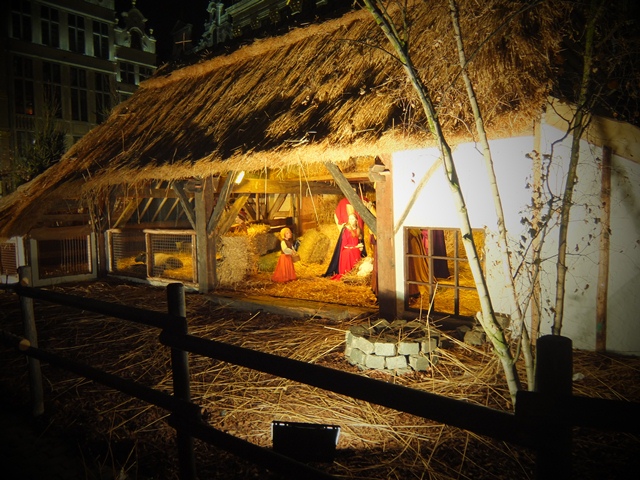 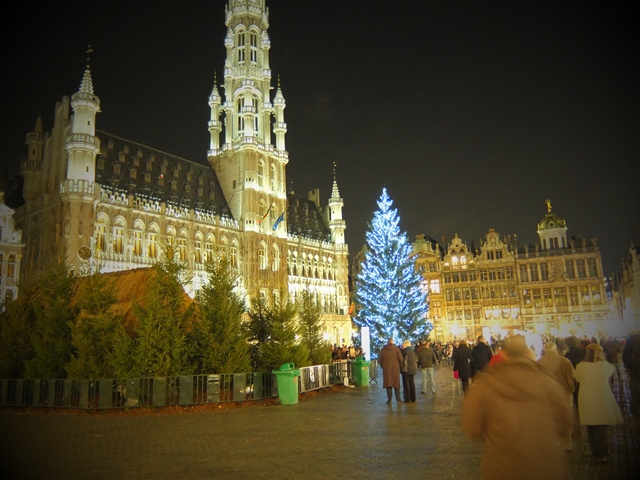 As tomorrow is Christmas Eve, the end of year approaches. Since Belgium is a country with many Catholics, I expected that the Christmas season would be no doubt very exciting, but so far, it is not so much the case. There are Christmas decorations in the shopping streets, but not as flashy as in Paris. The other night, when I visited the Grand Place in the centre of Brussels, there was a Christmas tree decorated with lights in the middle, but it was unexpectedly small. Last year they placed a modern-art Christmas tree constructed out of many 1m³ glass boxes with in-built lights, but it was unpopular among the local people, so this year they placed again a traditional Christmas tree using a fir tree. At a corner of the Grand Place, one can see a cattle stall where the scene of Jesus Christ’s birth is re-enacted and that’s where many tourists gather around. The characters are of course dolls, but there enclosed real sheep that appeared uncomfortable because of the cold. It feels as if the way of celebrating Christmas is “in recession”as well, reflecting the current economic and social situation. I hope that next Christmas will be a little bit more exciting. As tomorrow is Christmas Eve, the end of year approaches. Since Belgium is a country with many Catholics, I expected that the Christmas season would be no doubt very exciting, but so far, it is not so much the case. There are Christmas decorations in the shopping streets, but not as flashy as in Paris. The other night, when I visited the Grand Place in the centre of Brussels, there was a Christmas tree decorated with lights in the middle, but it was unexpectedly small. Last year they placed a modern-art Christmas tree constructed out of many 1m³ glass boxes with in-built lights, but it was unpopular among the local people, so this year they placed again a traditional Christmas tree using a fir tree. At a corner of the Grand Place, one can see a cattle stall where the scene of Jesus Christ’s birth is re-enacted and that’s where many tourists gather around. The characters are of course dolls, but there enclosed real sheep that appeared uncomfortable because of the cold. It feels as if the way of celebrating Christmas is “in recession”as well, reflecting the current economic and social situation. I hope that next Christmas will be a little bit more exciting.
< A Belgian Who Won the Nobel Prize in Physics >
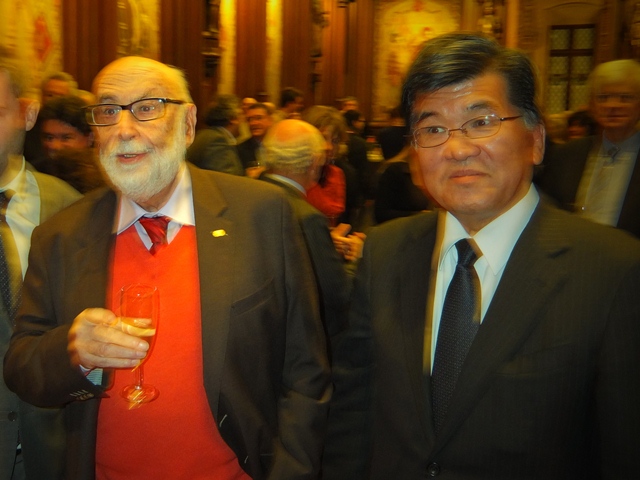 Last week, upon invitation, I attended a party at the City Hall of Brussels to celebrate Dr. François Englert who won the Nobel Prize in Physics this year. He is already over 80 years old but looked very energetic. The Nobel Prize was awarded to Dr. Englert for his prediction of the presence of the “Higgs Boson particle” which gives mass to matter. In fact, his prediction of half a century ago was proven correct in July last year by means of experiments with CERN (European Organization for Nuclear Research)’s large Hadron Collider. It is said that the prediction of the existence of the “Higgs particle” is based on the theory of Dr. Youichiro Nanbu (a Japanese american; former professor at the University of Chicago) who got the Nobel Prize in Physics in 2008 and as Japanese technology was useful for the experiments at CERN, I celebrate the prize of Dr. Englert for Japan too.。 Last week, upon invitation, I attended a party at the City Hall of Brussels to celebrate Dr. François Englert who won the Nobel Prize in Physics this year. He is already over 80 years old but looked very energetic. The Nobel Prize was awarded to Dr. Englert for his prediction of the presence of the “Higgs Boson particle” which gives mass to matter. In fact, his prediction of half a century ago was proven correct in July last year by means of experiments with CERN (European Organization for Nuclear Research)’s large Hadron Collider. It is said that the prediction of the existence of the “Higgs particle” is based on the theory of Dr. Youichiro Nanbu (a Japanese american; former professor at the University of Chicago) who got the Nobel Prize in Physics in 2008 and as Japanese technology was useful for the experiments at CERN, I celebrate the prize of Dr. Englert for Japan too.。
By the way, it took 36 years for Belgium to win the Nobel Prize after Dr. Ilya Prigogine (immigrant from Russia) was awarded the Nobel Prize in Chemistry in 1977. What is interesting is the common point that both are former professors at the Free University of Brussels (ULB). For that matter, Dr. Albert Claude, who won the Nobel Prize in Physiology or Medicine in 1974, was a professor at the ULB as well. Maybe there’s an academic culture at the ULB for enthusiastic basic research. Looking at the nationalities of the Nobel Prize Winners, you will notice that the vast majority are American or British (325 Americans, 111 Britons). Moreover, 3 out of the 4 people who won the Nobel Prize twice are American or British (the other one is Mrs. Marie Curie who obtained the French nationality). On the other hand, there are also people who are stateless (such as Ivan Bunin who was awarded the Nobel Prize in Literature in 1933) and people whose nationality is unknown (such as Dalai Lama XIV who was awarded the Nobel Peace Prize). Among the total number of Nobel laureates, there are 10 Belgians (of whom 5 won the prize before World War II) and 18 Japanese. Given the fact that the Belgian population is less than one tenth of Japan’s, having 5 Nobel laureates (even if taking just the post-war winners) is indeed splendid.
< Lotto Cross Cup and Tokyo Olympics >
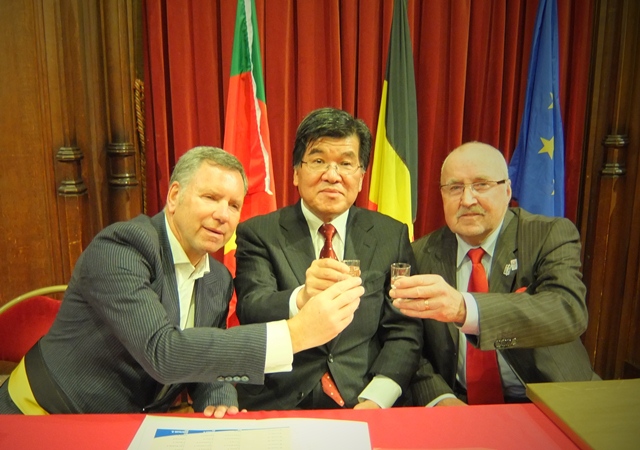 Last week, a press conference to announce the international cross-country competition called “Lotto Cross Cup” (December 22nd) was held in Brussels and I was invited as a special guest. Mr. Gaston Roelants, the gold medallist of the 3000-meter steeplechase at the Tokyo Olympics, attended this conference on behalf of the organizers of this competition. Besides setting two world records for the 3000-meter steeplechase, Gaston Roelants also set world records at the 20 km distance and the one-hour race, making him a star athlete in the 1960’s in long distance running worldwide. The Tokyo Olympics took place nearly 50 years ago, so the gold medallist of that time is now 76 years old. I was invited to this press conference not only because of the connection between the Tokyo Olympics of 1964 and Mr. Roelants, but also because Tokyo has been elected again as the venue of the 2020 Olympic Games. At that time in 1964, I was a third grade student at the junior high school and I watched the basketball game held in Yoyogi Gymnasium, but in track and field only the sad memory remains of Mr Koukichi Tsuburaya being overtaken by a British athlete just before the finish and winning the bronze medal in the marathon. Incidentally, one of the candidate cities and rivals of Tokyo in the process of determining the venue of the 1964 Olympic Games was Brussels. Well, as it was such a long time ago, less and less people know about those days. Last week, a press conference to announce the international cross-country competition called “Lotto Cross Cup” (December 22nd) was held in Brussels and I was invited as a special guest. Mr. Gaston Roelants, the gold medallist of the 3000-meter steeplechase at the Tokyo Olympics, attended this conference on behalf of the organizers of this competition. Besides setting two world records for the 3000-meter steeplechase, Gaston Roelants also set world records at the 20 km distance and the one-hour race, making him a star athlete in the 1960’s in long distance running worldwide. The Tokyo Olympics took place nearly 50 years ago, so the gold medallist of that time is now 76 years old. I was invited to this press conference not only because of the connection between the Tokyo Olympics of 1964 and Mr. Roelants, but also because Tokyo has been elected again as the venue of the 2020 Olympic Games. At that time in 1964, I was a third grade student at the junior high school and I watched the basketball game held in Yoyogi Gymnasium, but in track and field only the sad memory remains of Mr Koukichi Tsuburaya being overtaken by a British athlete just before the finish and winning the bronze medal in the marathon. Incidentally, one of the candidate cities and rivals of Tokyo in the process of determining the venue of the 1964 Olympic Games was Brussels. Well, as it was such a long time ago, less and less people know about those days.
< Christmas Market at Schloss Merode >
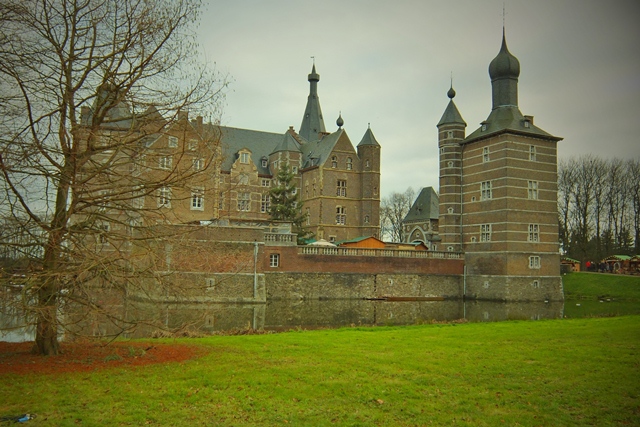 On the outskirts of a small town called “Langerwehe” near Aachen in Germany and 170km east of Brussels, there is a medieval castle called Schloss Merode. I had been invited for some time by the Merode family, so I paid a visit to them last Sunday. On that day, a big Christmas market was taking place with nearly 100 shops surrounding the castle, which was quite magnificent. The Merode family is an aristocratic family dating back to the Holy Roman Empire in the 11th century and played an important role in the Belgian Independence in 1830. The castle was founded in the 12th century, but later it was destroyed by repeated wars. Furthermore, it was destroyed almost completely by a big fire 13 years ago and the current castle seems to have been rebuilt recently. It is an old German tradition that the lord of the castle holds a Christmas market for his people in December and the Merode family has taken over that tradition until today. The large scale of the Christmas market of Schloss Merode is widely known in neighbouring villages and on the day I visited even a few sightseeing buses were parked on the parking, besides the numerous passenger cars. The lord and lady of the castle gave me a tour of the castle and while having a cup of tea I was able to talk for a while with their family and friends. I was told that a previous lord of the castle impersonated every year the main character, Charles V, at the “Ommegang” of Brussels, a world-famous historical parade. I understood that the lineage of European nobility has continued unbroken from the Middle Ages up to now. On the outskirts of a small town called “Langerwehe” near Aachen in Germany and 170km east of Brussels, there is a medieval castle called Schloss Merode. I had been invited for some time by the Merode family, so I paid a visit to them last Sunday. On that day, a big Christmas market was taking place with nearly 100 shops surrounding the castle, which was quite magnificent. The Merode family is an aristocratic family dating back to the Holy Roman Empire in the 11th century and played an important role in the Belgian Independence in 1830. The castle was founded in the 12th century, but later it was destroyed by repeated wars. Furthermore, it was destroyed almost completely by a big fire 13 years ago and the current castle seems to have been rebuilt recently. It is an old German tradition that the lord of the castle holds a Christmas market for his people in December and the Merode family has taken over that tradition until today. The large scale of the Christmas market of Schloss Merode is widely known in neighbouring villages and on the day I visited even a few sightseeing buses were parked on the parking, besides the numerous passenger cars. The lord and lady of the castle gave me a tour of the castle and while having a cup of tea I was able to talk for a while with their family and friends. I was told that a previous lord of the castle impersonated every year the main character, Charles V, at the “Ommegang” of Brussels, a world-famous historical parade. I understood that the lineage of European nobility has continued unbroken from the Middle Ages up to now.
< “The Nutcracker” in Antwerp >
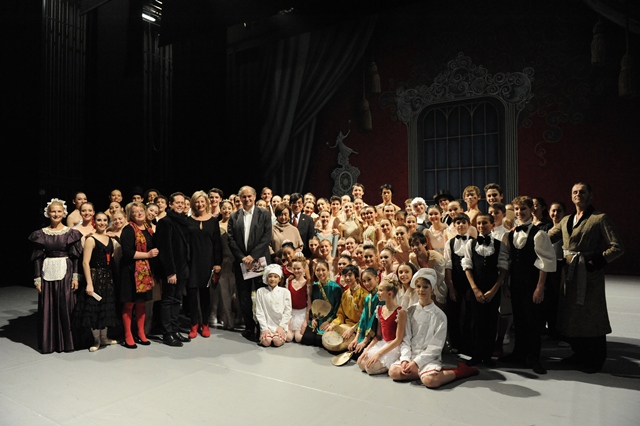 At the beginning of this month, I was invited to the periodic winter performance by the Royal Ballet School of Antwerp and watched the students perform the “The Nutcracker” ballet. There are many Japanese students (14 students at present) in this school where I met the principal and Japanese teachers and students when I paid a visit last June (see Ambassador’s Chat No. 19). In the performance on this day, Clara, the leading role (principal) in the first act and the Sugar Plum Fairy, the leading role in the second act, were performed by two Japanese girls. After the performance, we had the opportunity to take a group picture with the full cast. It was a really enjoyable evening. “The Nutcracker” is, as you may know, one of Tchaikovsky’s 3 major ballets and a standard piece in the Christmas season, but it is less known that the original author of the story is the German writer Ernst Hoffman. He was a writer of romances full of fantasy and horror, being active in the early 19th century. His unique literary world mixing reality and fantasy seems to have had a strong influence on writers (especially in France) and composers of that era. Wagner and Schumann as well left behind pieces of music that were inspired by Hoffman’s works. In Japan, Souseki Natsume’s “I Am A Cat” was inspired by “The Life And Opinions Of the Tomcat Murr”, a representative work of Hoffman’s later years, which is an anecdote that only few people know. Thinking vaguely about these things on a long winter night, I greatly enjoyed the ballet that was danced earnestly by the boys and girls. At the beginning of this month, I was invited to the periodic winter performance by the Royal Ballet School of Antwerp and watched the students perform the “The Nutcracker” ballet. There are many Japanese students (14 students at present) in this school where I met the principal and Japanese teachers and students when I paid a visit last June (see Ambassador’s Chat No. 19). In the performance on this day, Clara, the leading role (principal) in the first act and the Sugar Plum Fairy, the leading role in the second act, were performed by two Japanese girls. After the performance, we had the opportunity to take a group picture with the full cast. It was a really enjoyable evening. “The Nutcracker” is, as you may know, one of Tchaikovsky’s 3 major ballets and a standard piece in the Christmas season, but it is less known that the original author of the story is the German writer Ernst Hoffman. He was a writer of romances full of fantasy and horror, being active in the early 19th century. His unique literary world mixing reality and fantasy seems to have had a strong influence on writers (especially in France) and composers of that era. Wagner and Schumann as well left behind pieces of music that were inspired by Hoffman’s works. In Japan, Souseki Natsume’s “I Am A Cat” was inspired by “The Life And Opinions Of the Tomcat Murr”, a representative work of Hoffman’s later years, which is an anecdote that only few people know. Thinking vaguely about these things on a long winter night, I greatly enjoyed the ballet that was danced earnestly by the boys and girls.
< The Passing Away of the Former Honorary Consul-General >
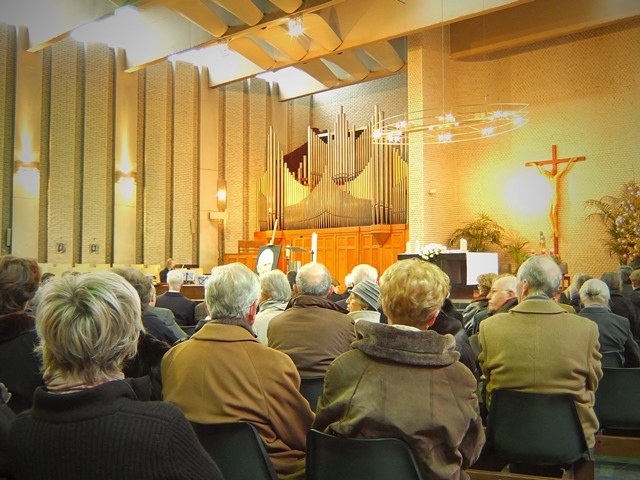 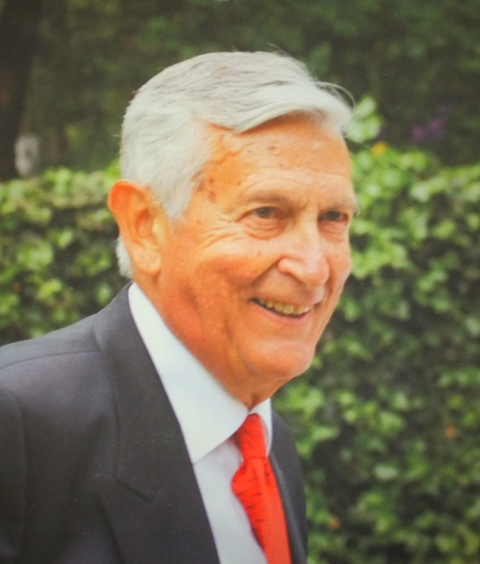 The other day, Mr. Rene Peeters, the former Honorary Consul-General of Japan in Antwerp, passed away at the age of 80. His funeral was held solemnly at a modern Catholic church in Antwerp two days ago. Mr. Peeters was an executive of Agfa-Gevaert, the manufacturer of chemicals and later he held the important position of Chairman of the Board of the Federation of Belgian Chemical Industries. In connection with Japan, he served as honorary consul-general in charge of Flanders (Dutch-speaking area) from 2000 to 2010. Though I have only met him a couple of times on the occasion of a reception, he gave the impression of a great gentleman. When he met Japanese people, I heard he told that he had visited Japan 25 times on business. May his soul rest in peace. The other day, Mr. Rene Peeters, the former Honorary Consul-General of Japan in Antwerp, passed away at the age of 80. His funeral was held solemnly at a modern Catholic church in Antwerp two days ago. Mr. Peeters was an executive of Agfa-Gevaert, the manufacturer of chemicals and later he held the important position of Chairman of the Board of the Federation of Belgian Chemical Industries. In connection with Japan, he served as honorary consul-general in charge of Flanders (Dutch-speaking area) from 2000 to 2010. Though I have only met him a couple of times on the occasion of a reception, he gave the impression of a great gentleman. When he met Japanese people, I heard he told that he had visited Japan 25 times on business. May his soul rest in peace.
|

